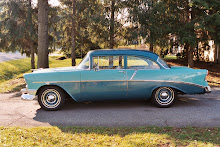By Carroll G Anderson
April, 2010
A century ago the United States had 2.5 million miles of roads, none of them paved. Less than half the streets in New York City were paved at the time. Around the same time the automobile was coming into its own and needed something besides mud, dust and ruts to really strut its stuff. Popular movements to connect American cities with real all weather roads had been developing over the past couple of decades but, in 1910, the American Road was pretty much just a dream.
Around the same time, in a totally unrelated (then or now) occurrence, the fortune of a British big-shot named Cecil Rhodes was used to fund the Rhodes Scholarship. It has become one of the world’s most prestigious scholarly awards and has been won by a number of famous Americans including Bill Clinton and Kris Kristofferson. Although I’m not a Rhodes Scholar and have never been to Oxford, Mississippi let alone Oxford and Cambridge Universities (where Rhodes Scholars study), I consider myself a true Roads Scholar.
While I’ve been interested in doing what you do on roads all my life: a road trip is entertainment of the finest kind as far as I’m concerned, I just recently became interested in the story of roads. When we moved to Middletown, Maryland we moved into a neighborhood bordered by the Old National Pike; a quarter mile from our front door the street on which we live intersects with one of America’s most historic roads.
U.S Route 40 was built along the route of the National Road, the first Federally funded road built to connect cities on the eastern seaboard with the Ohio River. That road was built to take advantage earlier cross-country efforts including Braddock’s Road from Cumberland, Maryland to Pittsburg, Pennsylvania. Braddock’s Road, built during the French and Indian Wars to enable colonial British forces to get to French military outposts in Western Pennsylvania, was itself build along Indian trails established by centuries of foot traffic between coastal tribes and those on the other side of the Appalachians.
In 1912 a coast-to-coast road, the National Old Trails Road or Ocean-to-Ocean Highway, was established. The 2,448 mile route incorporated the Old National Pike and the Santa Fe Trail as well as Indian Trails. Beginning in Baltimore and ending in Los Angeles, the Ocean-to-Ocean Highway had a long and storied career: less than 800 of those miles were ever paved, it was always tough to negotiate and it eventually became part of U.S. Route 40, U.S. Route 66, and, finally, parts of both Interstate 40 and Interstate 70.
While early travelers were bouncing along over the O-2-O the Nation was being dragged kicking and screaming into the 20th century by legislation that ultimately put the paving of America’s roads into the hands of the Federal government. By the mid-20’s the development of America’s highways was well underway. The “0” routes like 30 & 40 began connecting States east to west and vice versa. The “1” routes handled traffic traveling north and south. The numbering system was put in place at least in part to alleviate the confusion resulting from “naming” roads.
Named roads, while far more colorful than numbered routes, proved to be a handful; hard to agree upon and hard to remember. The Dixie Overland Highway, for instance, ran from Savannah, Georgia to San Diego, California while the King of Trails Highway carried travelers from Winnipeg, Canada to Brownsville, Texas. Even at the relatively slow speeds of 1925 it could take several road signs to read those names. Of course there weren’t too many alternatives to take a wrong turn onto.
Eventually many of the named cross-country roads became numbered U.S. Routes and finally Interstate Highways. Thinking about traveling across the country on graded (maybe) dirt roads, following signs painted on power or telephone poles, or roadside barns, certainly would enhance the adventure. But how much enhancement does your adventure need when it already involved riding for days in a Model T?
I’ve been around long enough to remember cross country trips on dirt roads, the two lane blacktop that replaced them and finally Interstates that go the same place. I gotta say, for covering a lot of distance in as little time as possible, nothing beats the Interstate. At the same time, if you want to see the country the two lane blacktop is the answer. Dirt roads, on the other hand, are what I call “off-roading.”
Every year or so I get an undeniable urge to cross the country and, regardless of the final destination, I take the Interstate. Almost weekly I get a smaller scale road trip urge I assuage with a ride on two-lane blacktop, almost never getting on the Interstate (until I have to kick it up a notch because I have to get home to the potty). Much less frequently these days I get an “off-roading” jones. In the first place, “off-roading” around here is apt to involve trespassing. Secondly, as I get older, I find myself more prone to “shaken geezer syndrome.” The more fun hurts, the easier it is to give up!
Saturday, April 24, 2010
Subscribe to:
Posts (Atom)
